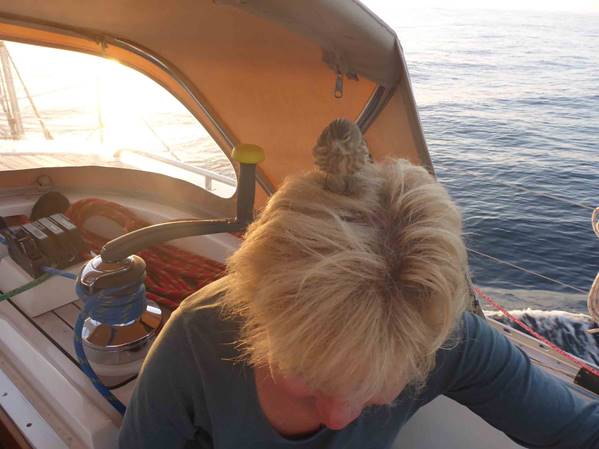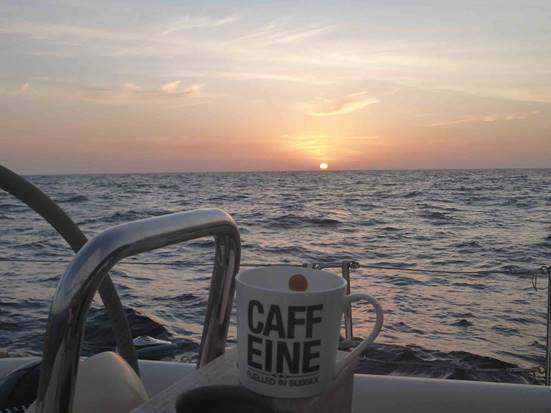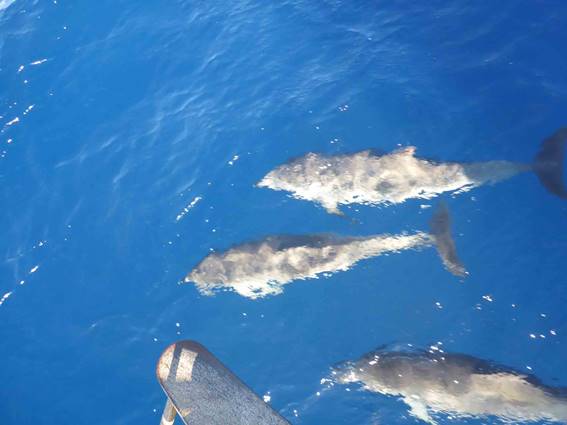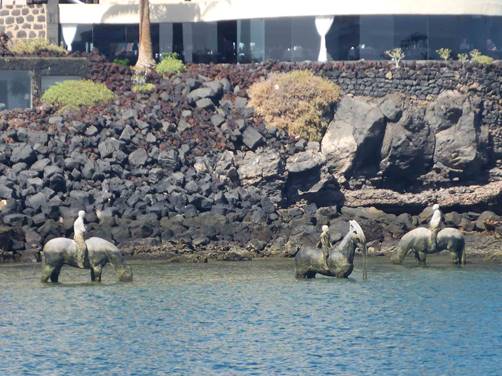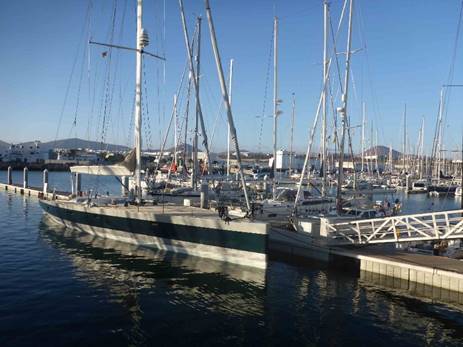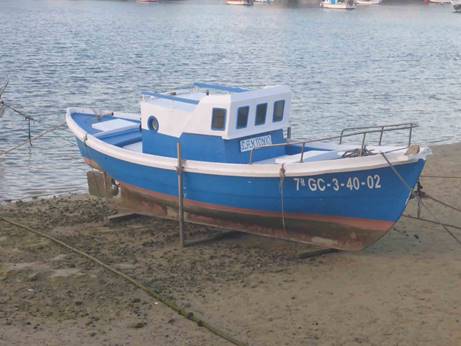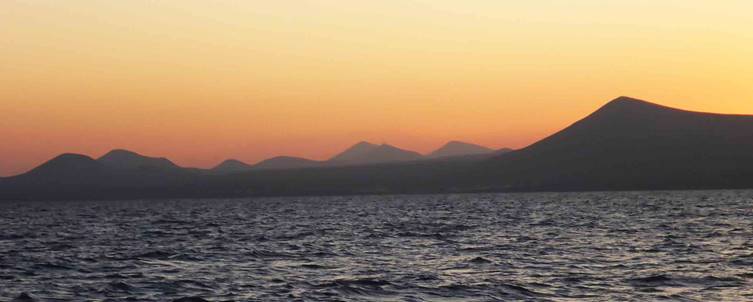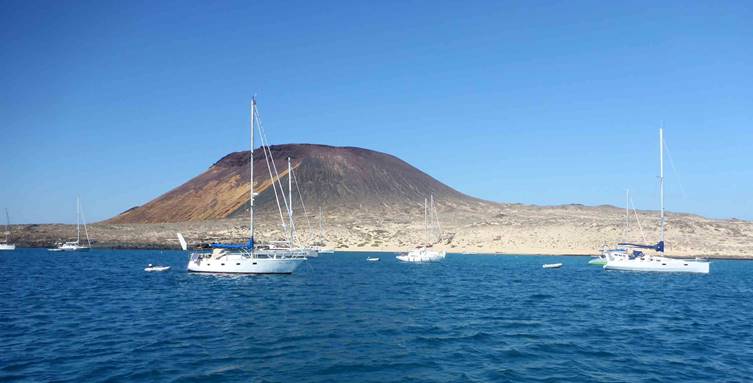31 Oct - Atlantic Islands

|
29:13N 13:31.7W
We spent half of Tuesday trying to return the hire car. The Manager had gone to Casablanca for the day and I was not happy. We used the time to visit a Moroccan supermarket – Marjane. Looks like a supermarket, only empty and without many things you might want to buy. Still, it was close to the boat and clean enough, so we stocked up on enough fresh victuals to sustain a four-day passage to the Canaries and informed the authorities of our intended departure. Wednesday started early. High water was at 0600, but the pilot did not want to get out of bed that early and I did not really want to negotiate the entrance in the dark if I didn’t need to, so we settled on 0730. That involved being nice to the Customs and Police people an hour before and much to my surprise, we left Rabat on the dot.
Early coffee needed to escape Rabat at sunrise! There was plenty of water in the entrance and we turned south west for the Canaries, some 475 miles away. If we could average 6 knots, that would mean a three-day passage. But for Escapade to make that kind of speed, we needed a favourable wind of over 10 knots. It was gusting up to 7 knots as we left, so we kept the ‘iron sail’ on and I started my mental arithmetic of fuel usage. We had left Rabat with around 475 litres of diesel, so there was little chance of running out, but it’s a big tank to fill and I hate spending money, so we agreed to sail as much as we could and stay at sea longer if necessary. The breeze came up in the afternoon, so up went the spinnaker and we slid along at around six knots as the haze lifted and the sun broke through. Julie made a splendid banana loaf and life was good!
An Atlantic sunset Mid afternoon, a fairly large whale surfaced alongside the boat, about 50 yards away. Probably a Minke, he was heading in the opposite direction and only breached the surface for a few seconds, but we sure smelt him! The whiff of stale breath and dead fish is quite unforgettable. Julie looked at me accusingly but I pointed to the disturbed water where he had disappeared. At sunset, we decided to take the spinnaker down for safety reasons – it’s a big old sail with quite a lot of string and carbon fibre attached to it if there was a problem in the dark, so a bigger risk of something breaking with no realistic prospect of repairs before Lanzarote. We set the genoa on the pole and accepted a loss of speed. By 0200 on Thursday morning, the wind had disappeared so the engine came back on to restore some forward momentum and charge the batteries. Gradually the breeze shifted into the north east, but the visibility dropped to a hundred yards or so. As I went off watch at 0400 we had enough breeze to sail and when I came back at 0800 we put the spinnaker back up. Thursday followed a very similar pattern, weather-wise. No wind in the afternoon, but the sun came out. No whale today, but a small corn bunting (similar to a wren) scrambled aboard just before sunset. He had got blown off course during his migration from Northern Europe and was now about forty miles west of Africa. I don’t think they like night flying much as a rule and he was clearly exhausted. He was surprisingly friendly – a colleague of his the previous evening, had got spooked by something shortly after landing aboard and was last seen ditching in the North Atlantic. But Bertie the Bunting was quite happy around us and took an instant liking to Julie’s hair. Eventually he settled down underneath the cockpit chartplotter, where he nibbled at some Moroccan bread and got his head down next to a safety harness.
Bertie was a bit forward in his approach…
…but I’d like to think he approved of our navigation. It was certainly better than his! Around 2100, whilst motoring due to a lack of wind, we felt an unusual vibration and noticed that the boat speed had dropped to three knots. Taking the engine out of gear, the boat stopped almost at once. Good chance that we had picked up a fishing net or something similar. We had a good look around, saw nothing obvious, so after a minute or so tried motoring astern. The boat picked up speed and behaved normally, without any vibration. We took it out of gear and waited another minute before coming ahead. No problem: whatever it was had gone. At dawn, Bertie went too. He took off, did a couple of circuits to calibrate his instruments, landed back on briefly and then flew off to the north. Wrong way, Mate - Africa is off to the east! I wondered whether a night next to that pesky chartplotter had scrambled his gyro? Sadly, we rated his chances of making land at close to zero. A stark reminder of the extraordinary lives that migrating birds lead, of the size of the planet and the key Law of Nature that says ‘only the strongest survive’. Friday’s cycle was the same. Spinnaker in the morning, engine in the afternoon, just enough wind overnight to pole out the genoa and keep moving. We saw very few other vessels throughout the passage. The odd cargo ship transiting, no yachts, a couple of fishing vessels working in water over a mile deep, mainly with long lines of baited hooks rather than trawling with nets. The VHF radio revealed the sheer boredom and ignorance of some of the watchkeepers: ‘Philipino Monkey’ was a cry we used to hear in the 1980s, disparagingly reflecting the vast number of hard-working professional seamen who emanate from that troubled Pacific archipelago. Well, he’s still on the radio, usually with an Indian or Sri Lankan accent these days.
Sunrise off Africa. Sun ‘lower limb’, more coffee please… Friday night’s migrator appeared just as we decided to gybe onto port tack in response to a wind shift. It was 0200, the decklights were on, we were both on deck, there were around thirty dolphins conducting ‘night flying’ attacks on our bow and a medium sized black bird with a bright red beak crash landed on the foredeck and installed himself by the mast. Not a great spot to choose during a gybe, so we tiptoed around him for a few moments to see if he was as tame as Bertie, but he wasn’t. He made a run for the ship’s side and was gone, into the darkness. I don’t think he could have been a guillemot as they are usually quite happy swimming… Otherwise the gybe passed off without incident and the boat settled back down. The breeze settled nicely giving us a good speed and once the sun came up, we hoisted the spinnaker once more.
Dolphin escort Just before 0900 on Saturday morning, I spotted the northern tip of Lanzarote in the haze – about thirty five miles away. An hour later, the wind had gone and we motored the last miles into the port of Arrecife, halfway down the east coast of Lanzarote.
Approaching Arrecife, Lanzarote The island is very volcanic, so mountainous but tree-less and uniformly dark brown in colour. The houses are white and mainly confined to the coastal fringe. No high-rise (apart from one hotel that evaded the planning regulations in the 1970s) and the place has a laid-back, quite sophisticated feel. We need to explore further.
Sculptures in the entrance to the port, much of which dates back 400 years
There is a fine ship lift here too!
The marina is very smart indeed, with plenty of room for the large number of transient yachts. We are particularly lucky to have a first class French patisserie at the top of the gangway – a reflection of advancing years, I suppose that the modern equivalent of the ‘duty watch bar’ sells vanilla, not vino…
Escapade tucked in bottom right amongst the posh yotties! Virtually everyone we have spoken to is doing the same as us. About a quarter are Brits, lots of Germans, a surprising number of Kiwis and Aussies. One English couple have been in the Canaries for thirteen years, so we thought they might be a good source of intelligence on nice anchorages and snorkelling. ‘Anchoring?’ she gasped ‘Oooh we never do that. The Marinas are so nice!’. They had only visited four islands in all those years. Note to self: don’t get stuck anywhere!
Arrecife fishing boat – pint sized! Arriving on Saturday afternoon, we took three and a half days. The passage was split roughly equally between spinnaker, ‘white sails’ and motoring. The ‘white sails’ time slowed us down, but it didn’t matter as the weather was very benign and the passage was very easy. The only problem we had was with the Iridium system, which still refused to cooperate with sending data – so my short blog on the first night at sea did not go until we hooked up to a GSM phone signal again at Lanzarote. Saturday afternoon was pretty sleepy; Sunday we did a few chores, wrote some blogs and went for a walk into town, which was largely shut and surprisingly ‘untouristy’. On Monday I contacted those nice chaps at Mailasail again to try and diagnose the Iridium illness, whilst Julie went to find fresh food – the Moroccan stuff was okay, but poor quality and anyway, we’d eaten it! By Monday afternoon the fridge was full, the Iridium working (a plugging problem, fortunately) and the weather forecast perfect to spend a couple of days ‘just chillin’ anchored off a small island north west of Lanzarote, called Isla Graciosa.
Lanzarote sunset This is a National Park, a bit like the Cies Islands near Vigo. The 25 mile passage was against the wind and as the Marina in Arrecife has no fuel, we had no option but to sail to windward. We arrived at 2130 in the dark, to find the anchorage quite full with about 25 yachts. The Pilot Book said that the best anchoring was in the centre of the bay or the western side, but it is difficult to judge distances accurately in the dark so we had no option but to drop the pick on the eastern edge. We are still here this morning! Light northerly breeze, glorious sunshine, 25o, crystal clear water. Sorry!
|


